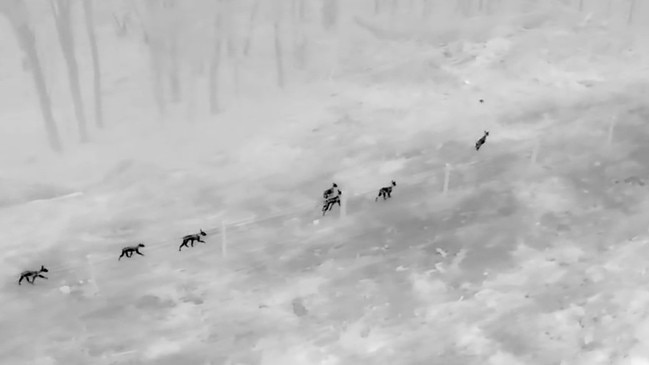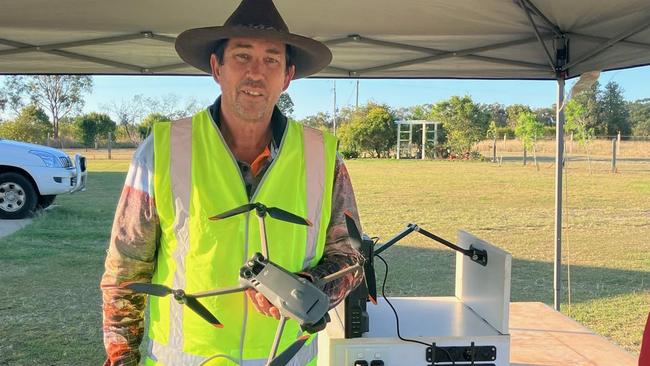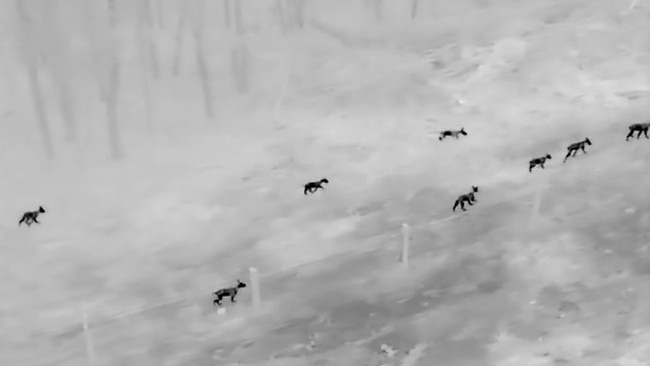Video | Thermal drone films dingo family west of Bundaberg
In thermal drone footage described as something you only see ‘once in a lifetime’, a female dingo and eight pups stalk a property fence line, as the worsening dry tightens its grip on Qld. SEE THE VIDEO
Community News
Don't miss out on the headlines from Community News. Followed categories will be added to My News.
Thermal drone footage taken in Queensland and rarely seen before shows a female dingo appearing to lead her eight pups along the fence line of a Burnett property, capturing a precious moment of what is said to be the mum teaching the young ones how to hunt.
Bundaberg Feral Pest Control owner Darren Pratt was out working with his thermal drone operator recently, contracted to eradicate wild pigs from a property, when out of thick scrub nearby came the pack of nine dingoes.
“They just came out of the bush and I was only about 15m away from them,”Mr Pratt said.
“You only see this once in a lifetime.”
Rich bloodlines: Behind 15 of Queensland’s wealthiest horse studs

Mr Pratt said he believed the dingoes were a pure breed, with a distinctive white spot on their tails and were eight pups following their mum as she taught them to hunt.
“You don’t usually see this many together,” he said.
The footage itself is surreal; the thick scrub appearing as a snow white desert and the dingoes’ dark black outlines making their way along what looks like a fence line.
Half way through the clip, a rabbit or hare moves through the fence directly in front of the dingoes and the leader of the pack starts a chase but quickly desists, followed moments later by a few pups copying her and checking the bush, despite the potential prey being long gone.

Mr Pratt works with a small team in Bundaberg Feral Pest Control to eradicate pigs and wild dogs around properties and he said he was seeing more and more pigs, wild dogs and dingoes “come in” with the drier conditions.
If cattle get weak and get caught in thick shrub or bush, they become a food source for the dingoes and wild dogs, he said.
“Usually if you have wild pigs, you’ll have wild dogs and dingoes.”
Mr Pratt works to help farmers dispose of the animals, and said he was constantly encountering poachers who did not have the proper licence for the job, especially as conditions drew more of the animals in.
“I’ve never seen it like this before,” he said.
“On average we’ll shoot or trap around 90 pigs a month.”

He has been getting more calls than he ever expected from Maryborough and down to Gympie, and with his sophisticated $20,000 drone set-up (including licences) he said he was able to work with more productivity and efficiency than before.
He also uses an electric buggy to drive around the property as it creates less noise and disturbance.
“With the drone it takes about 45 minutes to cover 1000 acres (405ha),” Mr Pratt said.
In that time they can pinpoint where the animals are and shoot or trap with accuracy.
“It’s also a lot safer,” he said.
One time he said he was aiming forward, but the drone pilot kept telling him to shoot off to the left, then he realised directly in front of him was an excavator, but couldn’t have seen it through the thick bush.
“The drone is also much more effective at night as through the day it will pick up rocks and won’t be as clear,” he said.
“I still end up walking a good 10km.
“Once you walk away from your buggy, you’re suddenly a good two or three km from it and you’ve always got to walk back.”




